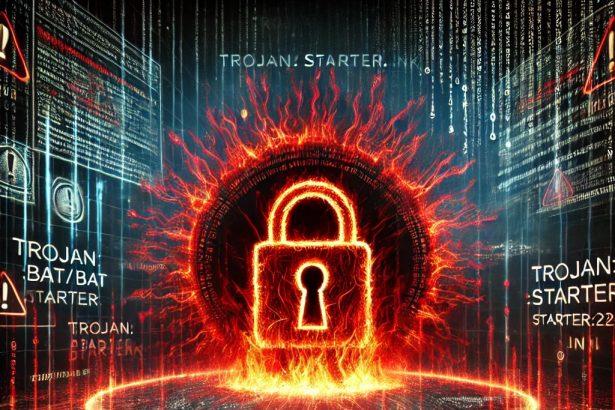Trojan:Win64/CrealStealer is a high-risk malware threat that poses as a legitimate Adobe Reader installer to trick users into downloading it. Once inside the system, it acts as a dropper—silently loading additional malware such as keyloggers, spyware, and even ransomware. This Trojan horse can remain undetected for long periods while cybercriminals exploit system weaknesses to harvest sensitive data and take remote control.
What Is Trojan:Win64/CrealStealer?
This threat is a stealthy Trojan that masks itself within cracked software, fake installers, or email attachments. Its primary goal is to infiltrate systems with low security and launch more dangerous malware payloads. By pretending to be part of a safe application, it bypasses user suspicion and conventional antivirus scans—until the symptoms start to appear.
Users are typically exposed to this malware through torrent platforms, cracked software sites, and spam emails with harmful attachments. After installation, it integrates itself deep into the system and changes crucial registry entries to maintain persistence and avoid detection.
Table: Trojan:Win64/CrealStealer Threat Summary
| Category | Details |
|---|---|
| Threat Name | Trojan:Win64/CrealStealer |
| Threat Type | Trojan Horse / Malware |
| Detection Names | Trojan:Win64/CrealStealer, Trojan.GenericKD, Win64/Dropper.CrealStealer |
| Symptoms of Infection | System slowdowns, frequent crashes, freezing, high CPU usage |
| Distribution Methods | Fake software installers, spam emails, torrent files, cracked applications |
| Damage Potential | Data theft, credential harvesting, remote access by hackers |
| Associated Emails | Spam emails with infected attachments (no specific address identified) |
| Danger Level | High |
| Recommended Tool | SpyHunter Malware Removal Tool |
Why Trojan:Win64/CrealStealer Is So Dangerous
Trojan:Win64/CrealStealer is not just a standalone threat—it is a gateway for further infections. Once installed, it connects to a remote command-and-control (C2) server. This enables attackers to:
- Control the victim’s system remotely.
- Install additional malware payloads.
- Exfiltrate sensitive data such as passwords and financial information.
- Use the infected system in broader cyberattacks (e.g., botnets or ransomware campaigns).
Its stealth tactics include hiding in system folders, using encryption, and creating registry keys that ensure it starts with every system reboot. Even if it’s removed, residual files or hidden processes can allow it to reinstall without user knowledge.
Manual Removal of Trojan Malware
Important: Manual removal is not recommended for beginners. It involves interacting with system files and the Windows Registry, which, if done incorrectly, can lead to system issues.
Step 1: Restart in Safe Mode with Networking
Booting into Safe Mode disables unnecessary startup programs, including most malware.
- Press Windows + R, type
msconfig, and hit Enter. - In the System Configuration window, go to the Boot tab.
- Check Safe boot, then select Network.
- Click Apply and restart your computer.
Step 2: Terminate Malicious Processes
- Open Task Manager using Ctrl + Shift + Esc.
- Navigate to the Processes or Details tab.
- Identify any unusual or unrecognized processes. Be cautious—do not stop critical Windows processes.
- Right-click a suspicious process, choose Open File Location, then End Task.
- Delete the associated file from the opened folder.
Step 3: Delete Trojan Files
- Press Windows + R, type
%appdata%, and press Enter. - Check for any unknown folders created recently.
- Repeat the same for these directories:
%localappdata%C:\Program FilesC:\Program Files (x86)C:\Windows\Temp
- Delete any folders or executables related to the Trojan.
Step 4: Clean Up the Windows Registry
- Press Windows + R, type
regedit, and press Enter. - Go to these registry paths:
HKEY_LOCAL_MACHINE\SOFTWARE\Microsoft\Windows\CurrentVersion\RunHKEY_CURRENT_USER\SOFTWARE\Microsoft\Windows\CurrentVersion\Run
- Look for registry entries with unusual names or links to suspicious files.
- Right-click and delete the unwanted entries.
Tip: Back up your registry before making changes by clicking File > Export in the Registry Editor.
Step 5: Reset Your Web Browsers
Malicious Trojans often tamper with browser settings to redirect users to unwanted sites.
Chrome
- Settings > Reset and clean up > Restore settings to their original defaults.
Firefox
- Help > More Troubleshooting Information > Refresh Firefox.
Edge
- Settings > Reset settings > Restore settings to their default values.
Step 6: Perform a Full System Scan with Windows Defender
- Open Windows Security from the Start menu.
- Click Virus & threat protection > Scan options.
- Choose Full Scan and click Scan now.
Step 7: Update Windows
- Go to Settings > Windows Update.
- Click Check for updates and install all available patches.
Method 2: Automatically Remove Trojans Using SpyHunter
Manual removal can be effective, but it’s time-consuming and may leave hidden components behind. SpyHunter is a trusted malware removal tool that automatically detects and eliminates Trojans and other threats.
Step 1: Download SpyHunter
Use the official download link: Download SpyHunter
Follow these instructions for installation: SpyHunter Download Instructions
Step 2: Install the Program
- Locate the downloaded file, usually SpyHunter-Installer.exe.
- Double-click it and follow the on-screen steps to complete the installation.
- Launch SpyHunter when finished.
Step 3: Scan Your PC
- Click the Start Scan Now button on the SpyHunter dashboard.
- Allow the scan to complete (it may take several minutes).
- Review the detected items.
Step 4: Remove Threats
- Click Fix Threats.
- SpyHunter will quarantine and remove the detected Trojan files automatically.
Step 5: Restart Your PC
Once the cleanup is finished, restart your system to finalize the changes.
Trojan Prevention Tips
- Avoid downloading software from unofficial sources.
- Be wary of email attachments, even from known contacts.
- Keep Windows and applications updated with the latest patches.
- Use a reputable security program like SpyHunter for active malware protection.
Conclusion
Trojan:Win64/CrealStealer is a deceptive and highly persistent malware threat that can compromise your entire system. It spreads through shady installers and email campaigns, and its stealthy nature makes it difficult to detect before it causes serious damage. If your device shows unusual behavior, such as slowing down or crashing frequently, this Trojan could be the culprit. To protect your system, immediate action is needed. Using a trusted malware removal tool like SpyHunter is highly recommended to scan and eliminate this threat.




